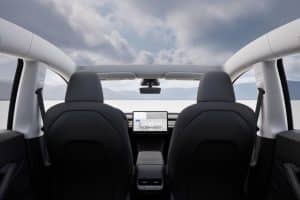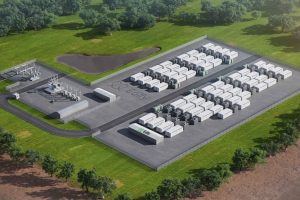The bad news just keeps coming for fossil energy stakeholders. High-performance, high-profile automakers have finally begun to validate electric mobility by putting up the big bucks for next-generation EV batteries. The latest example is Porsche AG, which has just polished its electrification cred by leading a round of $400 million in Series C funding for new silicon-lithium technology from the US firm Group14.
At this writing, Russia is continuing its murderou rampage through Ukraine. Millions are fleeing and in need of assistance. To help refugees from that conflict and others, donate to Doctors without Borders or other reliable aid organizations.
Silicon-Lithium Vs. Lithium-Ion
Group14 company sailed across the CleanTechnica radar in 2020, when the US Department of Energy tapped it to share in a $19 million funding pot aimed at improving silicon-lithium battery technology. The new round of assistance built on previous support including a slot in the 2020 Energy Storage Grand Challenge,
If you’re wondering what’s wrong with today’s generation of lithium-ion EV batteries, the short answer is: nothing. However, shuttling large numbers of EVs through public charging stations is going to be a challenge once millions of new EVs hit the road. Adding more charging stations is only part of the solution. Shortening the charging time while increasing range is the other part, and silicon could fit the bill.
The Silicon Difference
The Energy Department’s Pacific Northwest National Laboratory is among those promoting the silicon-lithium movement, so let’s have it explain the advantages.
“Silicon has long been appealing for use as a material in lithium-ion battery anodes, because its energy capacity is up to 10 times that of the commonly used material, graphite—leading to lithium-ion batteries with 20 to 40 percent higher energy density,” PNNL explains.
There being no such thing as a free lunch, there is a problem. Silicon anodes expand almost 300% during the charging process, when lithium ions crowd in. When the battery discharges, the lithium ions make an exit, leaving the silicon anode to wither back down to its original size.
As a result of the stress, the anode eventually cracks and disintegrates, with a consequent impact on battery life.
Earlier iterations of new silicon-lithium technology managed to work around the problem, but then cost factors in as an obstacle.
“Many of the proposed silicon anodes that hope to tolerate the flow of lithium will require expensive starting materials and complex synthesis processes that use specialized equipment, making it challenging to produce at commercially relevant scales and costs,” PNNL has noted.
The Group14 Solution For Better EV Batteries
PNNL has developed a low cost solution based on a coating of carbon. Carbon also factors into the Group14 solution.
Group14’s flagship product is a silicon-carbon powder marketed under the trademarked name SCC55™, and they are not shy about listing the advantages.
“SCC55™ has five times the capacity and affords up to 50% more energy density than conventional graphite for Lithium battery anodes,” Group14 states. “Its unique hard carbon-based scaffolding keeps silicon in the most ideal form — amorphous, nano-sized, and carbon-encased. The result is the best-in-class anode material that exhibits outstanding first cycle efficiency and long life upon Li-ion battery cycling.”
Considering supply chain issues bedeviling the global economy, the big question is whether or not Group14 and other silicon-lithium stakeholders can churn out high volumes of SCC55™ at a fast clip.
That does not appear appear to be an issue. Group14 emphasizes that its technology is based on abundant and “non-exotic” materials. In addition, the powder is tailor-able depending on a customer’s needs, and it can be integrated into existing fabrication lines on a drop-in basis. That means willing customers can put the stuff to work when they receive it, rather than investing time and money to retool their lines.
Porsche Banks On Better EV Batteries
Porsche has begun dipping into electrofuels technology, but EV batteries are the main focus of the company’s decarbonization plans, and the company appears determined to race ahead of the EV pack. Staking out a claim as a leading investor in new electrification technology appears to be part of the plan.
“Our investment in Group14 is an important step for Porsche’s M&A activities. We have been actively investing in ambitious companies since 2016 and through our venture capital unit Porsche Ventures, we have gained a deep understanding of the venture capital world and are excited to lead this round,” said Lutz Meschke, who is the deputy chairman and member of the executive board of Finance and IT at Porsche AG.”
The wheels are already in motion through Porsche subsidiary Cellforce Group, which is on track to produce lithium-silicon battery cells in Germany. Startup is planned for 2024.
Other Group14 activities include a commercial-scale factory up and running in the state of Washington. Another US factory is in the works for the US, and the company recently broke ground on a third factory in South Korea, under a joint venture with SK Group.
What About The Solid State Angle?
Good question! Group14 is already anticipating that its special powder will also find a home in new solid-state energy storage technology. That would dovetail with reports circulating last month around Porsche’s interest in solid-state EV batteries for its 911 moneymakers, which reflects parent company Volkswagen Group’s longrunning actitivies in the solid-state field.
However, Porsche has also indicated that it could lean on electrofuels to neutralize carbon emissions from its 911 models while providing diehard fans with the satisfaction of driving around with an internal combustion engine under the hood.
That makes sense from a bottom line perspective. Porsche has been playing to the retro crowd with its “Heritage Design” strategy, and it’s difficult to see how EV batteries fit into that picture.
The latest example is the re-launch of the 911 Sport Classic just last month, featuring a 7-speed manual transmission.
“Its engine, generating 543-hp and 442 lb.-ft. of torque, is the same 3.7-liter twin-turbo flat-six found in the 911 Turbo models with revised engine mapping to deliver output compatible with the manual transmission,” Porsche enthuses. “That combination also makes this the most powerful 911 with a manual transmission currently available.”
On the other hand, as more of the car buying public experiences the performance advantages of electric drive, perhaps Porsche will lean a little farther over in the electrification direction.




